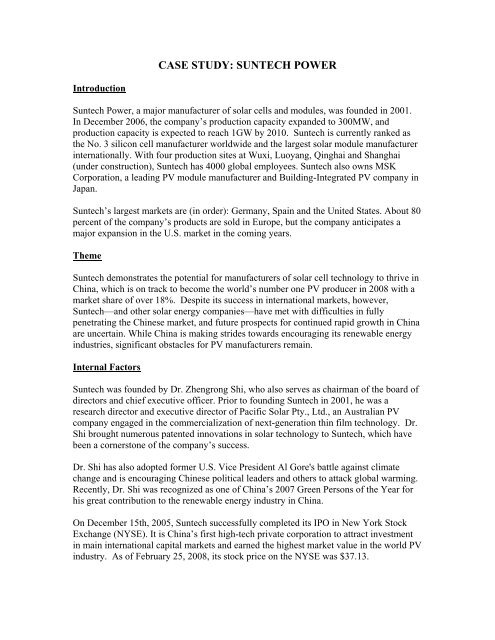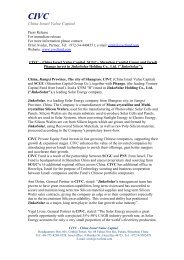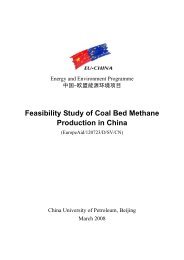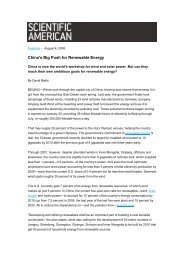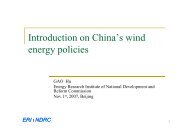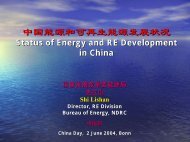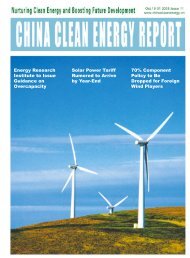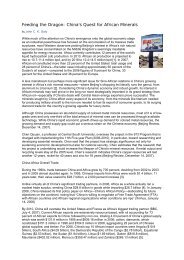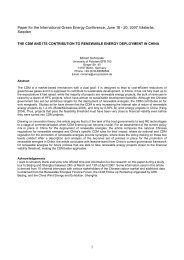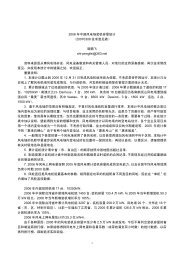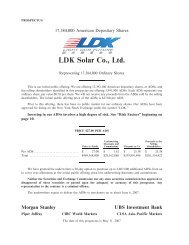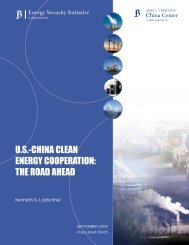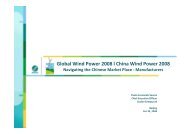Company Case Study: Suntech Power Holdings Co - Asia Europe ...
Company Case Study: Suntech Power Holdings Co - Asia Europe ...
Company Case Study: Suntech Power Holdings Co - Asia Europe ...
Create successful ePaper yourself
Turn your PDF publications into a flip-book with our unique Google optimized e-Paper software.
Introduction<br />
CASE STUDY: SUNTECH POWER<br />
<strong>Suntech</strong> <strong>Power</strong>, a major manufacturer of solar cells and modules, was founded in 2001.<br />
In December 2006, the company’s production capacity expanded to 300MW, and<br />
production capacity is expected to reach 1GW by 2010. <strong>Suntech</strong> is currently ranked as<br />
the No. 3 silicon cell manufacturer worldwide and the largest solar module manufacturer<br />
internationally. With four production sites at Wuxi, Luoyang, Qinghai and Shanghai<br />
(under construction), <strong>Suntech</strong> has 4000 global employees. <strong>Suntech</strong> also owns MSK<br />
<strong>Co</strong>rporation, a leading PV module manufacturer and Building-Integrated PV company in<br />
Japan.<br />
<strong>Suntech</strong>’s largest markets are (in order): Germany, Spain and the United States. About 80<br />
percent of the company’s products are sold in <strong>Europe</strong>, but the company anticipates a<br />
major expansion in the U.S. market in the coming years.<br />
Theme<br />
<strong>Suntech</strong> demonstrates the potential for manufacturers of solar cell technology to thrive in<br />
China, which is on track to become the world’s number one PV producer in 2008 with a<br />
market share of over 18%. Despite its success in international markets, however,<br />
<strong>Suntech</strong>—and other solar energy companies—have met with difficulties in fully<br />
penetrating the Chinese market, and future prospects for continued rapid growth in China<br />
are uncertain. While China is making strides towards encouraging its renewable energy<br />
industries, significant obstacles for PV manufacturers remain.<br />
Internal Factors<br />
<strong>Suntech</strong> was founded by Dr. Zhengrong Shi, who also serves as chairman of the board of<br />
directors and chief executive officer. Prior to founding <strong>Suntech</strong> in 2001, he was a<br />
research director and executive director of Pacific Solar Pty., Ltd., an Australian PV<br />
company engaged in the commercialization of next-generation thin film technology. Dr.<br />
Shi brought numerous patented innovations in solar technology to <strong>Suntech</strong>, which have<br />
been a cornerstone of the company’s success.<br />
Dr. Shi has also adopted former U.S. Vice President Al Gore's battle against climate<br />
change and is encouraging Chinese political leaders and others to attack global warming.<br />
Recently, Dr. Shi was recognized as one of China’s 2007 Green Persons of the Year for<br />
his great contribution to the renewable energy industry in China.<br />
On December 15th, 2005, <strong>Suntech</strong> successfully completed its IPO in New York Stock<br />
Exchange (NYSE). It is China’s first high-tech private corporation to attract investment<br />
in main international capital markets and earned the highest market value in the world PV<br />
industry. As of February 25, 2008, its stock price on the NYSE was $37.13.
Advantages:<br />
<strong>Suntech</strong>’s 2006 Annual Report reveals impressive results…<br />
Note: CAGR stands for compound annual growth rate.<br />
…and numerous competitive strengths:<br />
Large-Scale Manufacturing of High-Efficiency PV Cells<br />
Strong Research and Development Capabilities in PV technology<br />
Flexible China-based, Low-cost Manufacturing Model<br />
Established Relationships with Key Customers and Suppliers, including <strong>Co</strong>nergy<br />
AG, Atersa, IBC Solar AG, SolarWorld AG and Ibesolar Energia S.A.<br />
Leading independent developer and manufacturer of PV cells and modules with<br />
high growth and profitability<br />
Another major advantage that <strong>Suntech</strong> enjoys at present is a reduced tax rate. According<br />
to <strong>Suntech</strong>’s 2006 Annual Report, the basic enterprise income tax rate for foreigninvested<br />
enterprises in China is currently 33.0% (30.0% state tax and 3.0% local tax). The<br />
Chinese government has provided various incentives to foreign-invested enterprises and<br />
domestic companies operating in a national level economic and technological<br />
development zone, including reduced tax rates and other measures. For example, <strong>Suntech</strong><br />
China, is entitled to a preferential enterprise income tax rate of 15.0% so long as it
continues to operate in the high-tech zone and maintains its “high or new technology<br />
enterprise” status.<br />
However, <strong>Suntech</strong> may not benefit from such a low tax rate in the future. As of 2008,<br />
the PRC Enterprise Income Tax Law or the EIT Law will require China to adopt a<br />
uniform tax rate of 25.0% for all enterprises. Thanks to a grandfathering provision, this<br />
new tax rate will not apply to <strong>Suntech</strong> for five years, though there are no guarantees that<br />
the tax rate will not increase further in the future.<br />
Disadvantages:<br />
Despite the substantial growth it has experienced thus far, <strong>Suntech</strong> also identifies a<br />
number of internal risks in its 2006 Annual Report. These include the following<br />
assessments:<br />
Our failure to further refine our technology and develop and introduce new PV<br />
products could render our products uncompetitive or obsolete, and reduce our<br />
sales and market share.<br />
Our dependence on a limited number of suppliers for a substantial portion of<br />
silicon and silicon wafers could prevent us from delivering our products in a<br />
timely manner to our customers in the required quantities, which could result in<br />
order cancellations, decreased revenue and loss of market share.<br />
Our future success substantially depends on our ability to significantly increase<br />
both our manufacturing capacity and output. Our ability to achieve our expansion<br />
goals is subject to a number of risks and uncertainties.<br />
In addition to these risks, <strong>Suntech</strong> remains largely dependent on exports, though domestic<br />
sales have improved significantly as a percentage of total revenues since 2004.<br />
Year Ended December 31,<br />
2004 2005 2006<br />
Total Net<br />
Total Net<br />
Total Net<br />
Region<br />
Revenues % Revenues % Revenues %<br />
(in thousands except percentages)<br />
<strong>Europe</strong><br />
Germany $61,528 72.1% $101,590 45.0% $254,369 42.5%<br />
Spain 1,659 2.0 18,160 8.0 123,547 20.6%<br />
Others 13,033 15.3 41,537 18.4 43,784 7.3%<br />
<strong>Europe</strong> sub-total 76,220 89.4 161,287 71.4 421,700 70.4%<br />
China 6,705 7.8 56,400 25.0 129,704 21.7%<br />
South Africa 1,345 1.6 488 0.2 1,911 0.3%<br />
Rest of the world 1,018 1.2 7,825 3.5 45,555 7.6%<br />
Total $85,288 100.0% $226,000 100.0% $598,870 100.0%<br />
External Factors<br />
Advantages:
China’s natural landscape makes it a prime location for the development of solar energy.<br />
Two-thirds of China’s land area receives more than 2,000 hours of sunlight per year,<br />
which is more than either Japan or <strong>Europe</strong>. China’s potential solar energy production is<br />
equivalent to 1,700 billion tons of coal.<br />
On February 28 2005, China passed a historic law known as the Law on Renewable<br />
Energy Resources, which pledged to use renewable energy resources such as solar, wind<br />
and geothermal energy for 10% of energy consumption by 2020. The goal of the law is<br />
to “improve China’s energy structure, diversify energy supplies, safeguard energy<br />
security, protect the environment, and realize the sustainable development of the<br />
economy and society.” The law encourages the government to promote the use of photo<br />
voltaic cells in buildings as a means to promote China’s solar energy industry.<br />
Major upcoming events taking place in China, such as the 2008 Olympic Games in<br />
Beijing and the 2010 Shanghai Expo, will continue to stimulate the solar energy industry.<br />
In 2006, <strong>Suntech</strong> was awarded an exclusive contract to supply a 130 KW solar energy<br />
system for Beijing's Bird's Nest Stadium, the main stadium for the 2008 Beijing Olympic<br />
Games. The energy system will be installed at twelve entrances of the stadium.<br />
According to Solar Daily, industry specialists, who asked to remain anonymous,<br />
predicted that domestic consumption of solar power should improve in the next few<br />
years. As a result, firms are boosting their investments in anticipation of future growth.<br />
In addition, one source indicated that the central government would likely introduce<br />
policies this year to promote the domestic installation of alternative energies such as solar<br />
power.<br />
Disadvantages:<br />
Despite recent progress, China suffers from development challenges and, until recently, a<br />
dearth of laws and regulations that support renewable energy. Even with the Law on<br />
Renewable Energy Resources, China lacks a comprehensive nationwide plan for<br />
photovoltaic energy. "Manufacturers are expanding their capacity, but I don't see a major<br />
drive to install solar power domestically," said Wang Xing, a senior program officer at<br />
the Energy Foundation's China Sustainable Energy Program. "Right now there is not a<br />
very strong incentive program for solar power." 1<br />
A significant obstacle for solar energy is an inability to connect small-scale solar units to<br />
the larger power grid. "Currently, solar energy is only combined with power generation<br />
grid networks on a trial basis in first-tier cities like Beijing and Shenzhen," said Gao Hu,<br />
a researcher with the state-controlled Energy Research Institute 2 . Resource shortages –<br />
including the scarcity of adequate facilities, financial resources, and training<br />
opportunities—further hinder the development of solar technology.<br />
In its 2006 Annual Report, <strong>Suntech</strong> describes the following factors as competitive risks,<br />
many of which reflect the challenges of operating in China:<br />
1 Solar Daily<br />
2 Id.
The reduction or elimination of government subsidies and economic incentives<br />
for on-grid solar energy applications could have a material adverse effect on our<br />
business and prospects. Note: Because the installed cost of the company’s PV<br />
modules is upwards of 35¢ per KWh, government subsidies in export nations such<br />
as Germany and Japan are crucial to making the modules cost effective.<br />
If PV technology is not suitable for widespread adoption, or sufficient demand for<br />
PV products does not develop or takes longer to develop than we anticipated, our<br />
sales may not continue to increase or may even decline, and we may be unable to<br />
sustain profitability.<br />
We face intense competition from other companies producing solar energy and<br />
other renewable energy products. According to Photon International’s survey in<br />
March 2006, as of the end of 2005, 94 companies in the world produced PV cells<br />
and 153 companies produced PV modules.<br />
The Chinese economy differs from the economies of most developed countries in<br />
many respects, including: the amount of government involvement; the level of<br />
development; the growth rate; the control of foreign exchange; and the allocation<br />
of resources. While the Chinese economy has grown significantly in the past 20<br />
years, the growth has been uneven, both geographically and among various<br />
sectors of the economy.<br />
The PRC government has implemented various measures to encourage economic<br />
growth and guide the allocation of resources. Some of these measures benefit the<br />
overall Chinese economy, but may also have a negative effect on us. For<br />
example, our financial condition and results of operations may be adversely<br />
affected by government control over capital investments or changes in tax<br />
regulations that are applicable to us.<br />
<strong>Co</strong>nclusion<br />
<strong>Suntech</strong>’s booming growth and strong sales abroad demonstrate the potential for solar<br />
energy companies to succeed in China. In recent years, low manufacturing costs, better<br />
technology, and efficient production have helped companies like <strong>Suntech</strong> to remain<br />
competitive. The Chinese solar industry has also attracted significant attention<br />
worldwide. In September 2007, the International Solar Energy Society hosted its Solar<br />
World <strong>Co</strong>ngress in Beijing to help promote sustainable development in the solar industry<br />
in China and other nations.<br />
Despite all the progress, however, China’s installed capacity for PV power is only 80<br />
MW, which is just 0.016 percent of the installed thermal power capacity. Price wars<br />
leading to lower quality products and the lack of financial and policy support from<br />
government remain as significant barriers. Traditional power companies have also failed<br />
to develop their own solar energy technology and to provide solar energy with ready<br />
access to the grid. As a result, <strong>Suntech</strong> and other companies find that domestic sales are<br />
less than a quarter of total net revenues, and prospects for growth in the domestic market<br />
remain uncertain. Moreover, in international markets, <strong>Suntech</strong> remains highly dependent<br />
on subsidies from governments in developed countries, and any reduction in subsidy
levels would hurt business badly. Still, Rhone Resch, President of Solar Energy<br />
Industries Association, says he does not expect those subsidies to go away any time soon.<br />
“I think investors recognize that solar, although small, makes sense.” 3<br />
For solar energy to comprise a higher percentage of growth in domestic Chinese<br />
consumption, companies such as <strong>Suntech</strong> will need to increase efficiency and lower costs<br />
associated with PV. In order to do so, they will need to develop technology that can<br />
produce more electricity with less land being taken up by solar modules. Currently, a<br />
kilowatt-hour of electricity made with coal costs about 4 cents in China. An equivalent<br />
amount made from solar energy costs approximately 10 times this much. Electricity from<br />
wind energy costs about double, so China's government has recently subsidized wind—<br />
and wind investment has soared.<br />
In order to remain competitive, China will need to provide <strong>Suntech</strong> and other solar<br />
companies with subsidies and policy measures that can help them sustain their advantage<br />
in manufacturing costs. Wang Wenjing, a solar energy expert at the Chinese Academy of<br />
Sciences, says he thinks that solar subsidies are only a year or two away. "The lack of<br />
government policy is constraining the use of solar energy," he says. "If the government<br />
would just come out with a policy, I'm certain China could very quickly become the<br />
world's largest user of solar energy." 4<br />
While difficulties remain in the short term and domestically, long-term prospects for PV<br />
made in China look promising. According to the Research and Markets, from 2020 to<br />
2030, solar energy will enter into mainstream energy markets worldwide on a large scale.<br />
Technical progress together with scale effects will steadily reduce the cost of PV<br />
batteries. The research firm cites cost curve figures of the PV industry in the past 40<br />
years that have shown that costs will come down 15-20% once accumulated sales volume<br />
of PV batteries is doubled. The firm also estimates that solar power generation cost in<br />
developed countries will approach electricity prices for the peak period from 2010 to<br />
2030; and it will approach average electricity prices from 2020 to 2050.<br />
To fully take advantage of global demand for solar energy, <strong>Suntech</strong> must continue to<br />
develop new and innovative technologies and increase its production capacity. With the<br />
proper support, <strong>Suntech</strong> should continue to thrive in the years to come.<br />
Sources<br />
<strong>Suntech</strong> website<br />
<strong>Suntech</strong> 2006 Annual Report<br />
Solar Daily,<br />
http://www.solardaily.com/reports/Cloudy_Outlook_For_China_Solar_Industry_999.<br />
html<br />
World Watch Institute, http://www.worldwatch.org/node/41<br />
3 Red Herring.<br />
4 NPR.
RSC,<br />
http://www.rsc.org/chemistryworld/Issues/2007/November/Solar<strong>Power</strong>HeatsUpInChi<br />
na.asp<br />
Manufacturing and Technology News,<br />
http://www.manufacturingnews.com/news/08/0110/art1.html<br />
Green Jobs, http://www.greenjobs.com/Public/IndustryNews/inews00597.htm<br />
NPR, http://www.npr.org/templates/story/story.php?storyId=17351206<br />
Red Herring, http://www.redherring.com/Home/14881<br />
Research and Markets, http://www.researchandmarkets.com/reports/c77145<br />
Prepared by Keya Chateauneuf 3/5/2008


